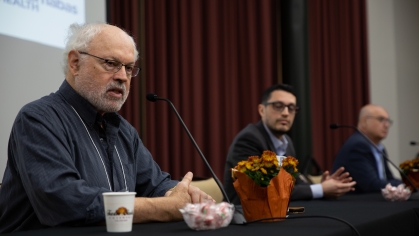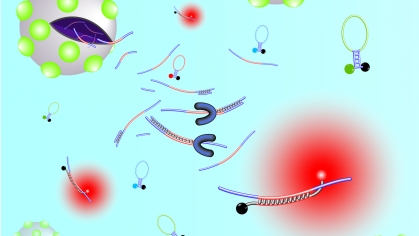How the Mongolian Gerbil May Help Speed Recovery of a Rare Inner Ear Problem

Rutgers scientists develop testing model to enhance understanding of a condition known as “third window syndrome”
To patients of P. Ashley Wackym, a surgical otologist-neurotologist at Rutgers Robert Wood Johnson Medical School, a diagnosis of superior semicircular canal dehiscence (SSCD) can feel like a death sentence.
SSCD, a type of “third window syndrome,” is caused by an abnormal third mobile window of the inner ear. Normally humans have two of these windows. When a third “window” is present – at birth, after trauma or for reasons that remain unclear – patients can suffer sound-induced dizziness, hearing internal sounds unusually well (one-third can hear their eyes move or blink), and chronic headaches.
Patients can also suffer cognitive dysfunction – such as impaired memory, poor concentration, spatial disorientation, slurred speech, out-of-body experiences and crippling anxiety.
“If you could just blow my head off, I’d let you,” one patient said she told her husband after receiving a diagnosis of SSCD. Vertigo, nausea, confusion and other symptoms of the rare inner ear problem had made everyday tasks – from shopping to listening to music – unbearable. “I cannot live like this,” she said.
Wackym, Todd Mowery and other colleagues in the Department of Otolaryngology – Head and Neck Surgery are working to speed the recovery of patients like this one, and a Mongolian gerbil with an ear structure like humans could help eventually help researchers better understand the cognitive challenges and facilitate recovery.
Their findings are published in the neuro-otology section of the journal Frontiers in Neurology.
“We don’t know what part of the brain is impacted by this disorder,” said Wackym. “That's where the animal model comes in. With this model we might be able to understand the nervous system pathways affected by SSCD and develop interventions to prevent this dysfunction or accelerate recovery.”
As much as two percent of the U.S. population has SSCD, which was first medically identified in 1998. “While surgery can plug the third hole, based upon neuropsychology studies in these patients, full cognitive recovery can take between three and 18 months,” Wackym said.
To develop the animal testing model, 36 adult Mongolian gerbils were randomly divided into two groups, which received either a small (one millimeter) or large (two millimeter) semicircular canal fenestration in their inner ear. This procedure created an artificial third window.
The researchers then studied how the animals responded to pressure and sound stimulation. They found that the large window resulted in similar electrophysiologic findings as observed in human patients with SSCD.
They also discovered the bony holes created in the animal’s inner ear healed spontaneously, with all hearing and balance functioning returning to baseline. “This will enable future studies to test SSCD conditions before, during and after recovery — findings that could be applied to human patients,” Wackym said.
“If we knew what was impacted and what was involved with the central neuroplasticity of SSCD, we could develop interventions that might speed up the human-recovery process,” he said. “As the first successful animal model for SSCD, this tool will help neuroscientists better understand the anatomy and pathology of SSCD cognitive dysfunction.”



